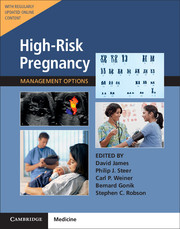Book contents
- Frontmatter
- Contents
- List of Contributors
- Preface
- Section 1 Prepregnancy Problems
- Section 2 Early Prenatal Problems
- Section 3 Late Prenatal – Fetal Problems
- Section 4 Problems Associated with Infection
- Section 5 Late Pregnancy – Maternal Problems
- 30 Substance Misuse in Pregnancy
- 31 Medication in Pregnancy
- 32 Hypertension in Pregnancy
- 33 Cardiac Disease in Pregnancy
- 34 Respiratory Disease in Pregnancy
- 35 Anemia and White Blood Cell Disorders in Pregnancy
- 36 Hematological Malignancies in Pregnancy
- 37 Thrombocytopenia and Bleeding Disorders in Pregnancy
- 38 Disorders of Coagulation in Pregnancy
- 39 Autoimmune Disease in Pregnancy
- 40 Diabetes in Pregnancy
- 41 Thyroid Disease in Pregnancy
- 42 Pituitary and Adrenal Disease in Pregnancy
- 43 Gastrointestinal and Liver Diseases in Pregnancy
- 44 Neurologic Complications in Pregnancy
- 45 Renal Disorders in Pregnancy
- 46 Spine and Joint Disorders in Pregnancy
- 47 Skin Disease in Pregnancy
- 48 Malignant Disease in Pregnancy
- 49 Pregnancy After Transplantation
- 50 Trauma in Pregnancy
- 51 Mental Health Disorders in Pregnancy
- Section 6 Late Prenatal – Obstetric Problems
- Section 7 Postnatal Problems
- Section 8 Normal Values
- Index
46 - Spine and Joint Disorders in Pregnancy
from Section 5 - Late Pregnancy – Maternal Problems
- Frontmatter
- Contents
- List of Contributors
- Preface
- Section 1 Prepregnancy Problems
- Section 2 Early Prenatal Problems
- Section 3 Late Prenatal – Fetal Problems
- Section 4 Problems Associated with Infection
- Section 5 Late Pregnancy – Maternal Problems
- 30 Substance Misuse in Pregnancy
- 31 Medication in Pregnancy
- 32 Hypertension in Pregnancy
- 33 Cardiac Disease in Pregnancy
- 34 Respiratory Disease in Pregnancy
- 35 Anemia and White Blood Cell Disorders in Pregnancy
- 36 Hematological Malignancies in Pregnancy
- 37 Thrombocytopenia and Bleeding Disorders in Pregnancy
- 38 Disorders of Coagulation in Pregnancy
- 39 Autoimmune Disease in Pregnancy
- 40 Diabetes in Pregnancy
- 41 Thyroid Disease in Pregnancy
- 42 Pituitary and Adrenal Disease in Pregnancy
- 43 Gastrointestinal and Liver Diseases in Pregnancy
- 44 Neurologic Complications in Pregnancy
- 45 Renal Disorders in Pregnancy
- 46 Spine and Joint Disorders in Pregnancy
- 47 Skin Disease in Pregnancy
- 48 Malignant Disease in Pregnancy
- 49 Pregnancy After Transplantation
- 50 Trauma in Pregnancy
- 51 Mental Health Disorders in Pregnancy
- Section 6 Late Prenatal – Obstetric Problems
- Section 7 Postnatal Problems
- Section 8 Normal Values
- Index
Summary
Introduction
During pregnancy, maternal anatomic changes present mechanical challenges to the musculoskeletal system. The enlarging gravid uterus alters the maternal body's center of gravity, mechanically stressing the axial and pelvic systems, compounding the stresses brought about by the hormonal changes and fluid retention associated with pregnancy. Complaints of musculoskeletal discomfort during pregnancy are common and may be temporarily disabling. It is estimated that virtually all woman experience some degree of musculoskeletal discomfort during pregnancy, and 25% have at least some temporarily disabling symptoms. These problems usually resolve spontaneously with completion of pregnancy, but occasionally they may remain as chronic disorders. In addition, some musculoskeletal conditions that exist prior to pregnancy may affect the course of the pregnancy.
Low Back and Pelvic Girdle Pain
General Considerations
Having been described by Hippocrates and others through the course of the past two millennia, pregnancy-related lower back pain was more definitively characterized by Walde in 1962, who recognized two patterns of low back pain: lumbar pain and pelvic girdle pain. Setting aside the enduring debate as to whether pregnancy-related back pain is an inevitable or even an essential component of healthy pregnancy, the personal and societal toll is astounding. One study reported that nearly 20% of women suffering with severe low back pain during pregnancy elected to not have another pregnancy because of fear related to recurrence. And as many as 30% of women will need to take sick leave from work, and the pain may persist for over 6 months in 6% of patients. Nighttime backache afflicts over 60% of women, and in more than a third it is so severe that it wakes them from sleep. Persistent pelvic girdle pain has even been found to persist for 2 years beyond postpartum in as many as 8.5% of afflicted patients. Nonetheless, the etiology remains theoretical and its description, until more recently, imprecise.
In 2003, Wu and coworkers published a metaanalysis of English-language papers concerning “pregnancy-related pelvic girdle pain” (PPP) and “pregnancy-related low back pain” (PLBP), considered together to be “lumbopelvic pain.” They found 761 papers, of which 106 contained sufficient material for analysis. They concluded that about 45% of women have lumbopelvic pain during pregnancy and 25% have lumbopelvic pain after pregnancy.
- Type
- Chapter
- Information
- High-Risk Pregnancy: Management OptionsFive-Year Institutional Subscription with Online Updates, pp. 1367 - 1397Publisher: Cambridge University PressFirst published in: 2017



